I want to plot segmented data in R. That is, say I have data of the form
| Product | Date | Origination | Rate | Num | Balance |
|-----------------------|--------|-------------|------|-----|-----------|
| DEMAND DEPOSITS | 200505 | 198209 | 0 | 1 | 2586.25 |
| DEMAND DEPOSITS | 200505 | 198304 | 0 | 1 | 3557.73 |
| DEMAND DEPOSITS | 200505 | 198308 | 0 | 1 | 14923.72 |
| DEMAND DEPOSITS | 200505 | 198401 | 0 | 1 | 4431.67 |
| DEMAND DEPOSITS | 200505 | 198410 | 0 | 1 | 44555.23 |
| MONEY MARKET ACCOUNTS | 200505 | 198209 | 0.25 | 2 | 65710.01 |
| MONEY MARKET ACCOUNTS | 200505 | 198211 | 0.25 | 2 | 41218.41 |
| MONEY MARKET ACCOUNTS | 200505 | 198304 | 0.25 | 1 | 61421.2 |
| MONEY MARKET ACCOUNTS | 200505 | 198402 | 0.25 | 1 | 13620.17 |
| MONEY MARKET ACCOUNTS | 200505 | 198408 | 0.75 | 1 | 281897.74 |
| MONEY MARKET ACCOUNTS | 200505 | 198410 | 0.25 | 1 | 5131.33 |
| NOW ACCOUNTS | 200505 | 198209 | 0 | 1 | 142744.35 |
| NOW ACCOUNTS | 200505 | 198303 | 0 | 1 | 12191.6 |
| SAVING ACCOUNTS | 200505 | 198301 | 0.25 | 1 | 96936.24 |
| SAVING ACCOUNTS | 200505 | 198302 | 0.25 | 2 | 21764 |
| SAVING ACCOUNTS | 200505 | 198304 | 0.25 | 1 | 14646.55 |
| SAVING ACCOUNTS | 200505 | 198305 | 0.25 | 1 | 20909.7 |
| SAVING ACCOUNTS | 200505 | 198306 | 0.25 | 1 | 66434.56 |
| SAVING ACCOUNTS | 200505 | 198309 | 0.25 | 1 | 20005.56 |
| SAVING ACCOUNTS | 200505 | 198404 | 0.25 | 2 | 16766.56 |
| SAVING ACCOUNTS | 200505 | 198407 | 0.25 | 1 | 47721.97 |
I want to plot on the Y-axis a line per 'Product' type by 'Balance'. On the X-axis, I want to put the 'Origination'. I would ideally also like to set colors to distinguish between the lines. The data is not currently in data.frame form so let me know if I need to change back to that.
I haven't been able to find an informative solution online for this, even though I'm sure there is.
Thanks,

